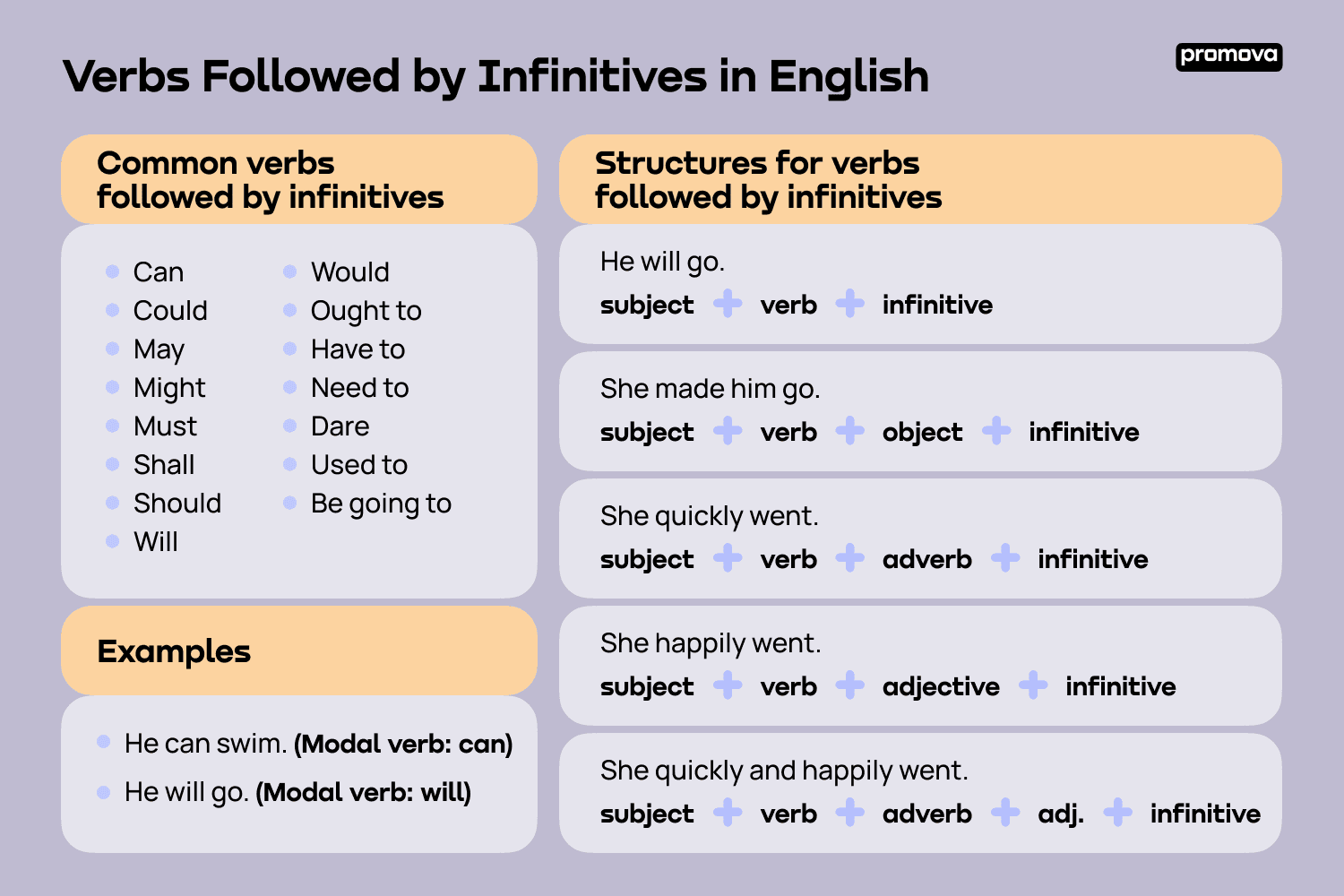Verbs Followed by Infinitives in English
Contents
One of the most challenging aspects of English grammar is the concept of verbs followed by infinitives. It's especially challenging for non-native speakers who are not used to the structure of sentences yet.
In this reference, we'll discuss what verbs followed by infinitives are, the different types of verbs followed by infinitives, examples, rules, common verbs, and tips for using them correctly.
Verbs followed by infinitives in grammar
Verbs followed by infinitives are a special type of verb phrase. In English grammar, a verb phrase combines a verb with one or more complements, including infinitives. An infinitive is a verb form which isn't conjugated, so it does not have a subject. For example, the verb "to do" is an infinitive.
Verbs followed by infinitives are used to express certain ideas, such as intentions, desires, or requests. They are often used to describe an action that someone or something will do in the future, or to express a possibility. For example, "I want to go to the park." In this sentence, the verb "want" is followed by the infinitive verb "to go", which expresses the speaker's desire to go to the park.
So, they are an important part of sentence structure and can be used to express a wide range of ideas and emotions. These phrases can help describe actions or events that may or may not happen.

Examples of Verbs Followed by Infinitives
Examples of verbs followed by infinitives:
- He can swim. (Modal verb: can)
- She should go. (Modal verb: should)
- I must finish my homework. (Modal verb: must)
- We have to study. (Auxiliary verb: have)
- They ought to try. (Modal verb: ought to)
- He will go. (Modal verb: will)
- She would like to go. (Modal verb: would)
- I had to study. (Auxiliary verb: had)
Rules for Verbs Followed by Infinitives
When using verbs followed by infinitives, there are a few rules that can help ensure that your sentence is grammatically correct.
- Your verb must agree with the subject in number. For example, if the subject is singular, then the verb must be singular as well.
- Your verb must agree with the infinitive in voice. For example, if the infinitive is in the active voice, then the verb must also be in the active voice.
- Your verb must agree with the infinitive in tense. For example, if the infinitive is in the present tense, then the verb must also be in the present tense.
So, here is how this looks like in sentences:
- He can swim (singular verb, active voice, present tense)
- She should go (singular verb, active voice, present tense)
- We have to study (plural verb, active voice, present tense)
- They ought to try (plural verb, active voice, present tense).
Common Verbs Followed by Infinitives
There are many common verbs followed by infinitives in English. Here are some of the most commonly used verbs:
- Can
- Could
- May
- Might
- Must
- Shall
- Should
- Will
- Would
- Ought to
- Have to
- Need to
- Dare
- Used to
- Be going to
Structures for Verbs Followed by Infinitives
Verbs followed by infinitives can be used in a variety of structures. Here are some of the most common structures:
- Subject + verb + infinitive: He will go.
- Subject + verb + object + infinitive: She made him go.
- Subject + verb + adverb + infinitive: She quickly went.
- Subject + verb + adjective + infinitive: She happily went.
- Subject + verb + adverb + adjective + infinitive: She quickly and happily went.
8
Tips for Using Verbs Followed by Infinitive
Using verbs followed by infinitives correctly can be tricky, but there are a few tips that you can use to help you master this grammar concept.
First, be sure to pay attention to the agreement between the verb and the infinitive. As mentioned earlier, the verb must agree with the infinitive in number, voice, and tense.
Second, be aware of the different structures that can be used with verbs followed by infinitives. As you can see, different structures can be used for it.
Third, pay attention to the context of the sentence. Sometimes, the meaning of the sentence can be changed slightly by changing the verb or the infinitive.
Finally, practice using verbs followed by infinitives in your writing. If you use them often, this will become intuitive!
Summary
Verbs followed by infinitives can be used to express a wide range of ideas and emotions, and they are a key part of sentence structure. With the help of a few examples, you should be able to understand the concept and use it in your English very soon!



Comments